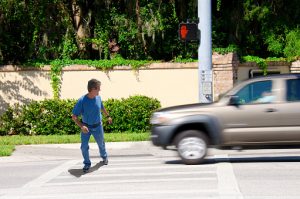Road Width Impacts Atlanta Pedestrian Safety
 Most people don't think about how wide roads are, but wide roads can impact driver behavior. A driver who is on a wider road tends to feel a greater sense of space and be more confident he can see and respond to obstacles surrounding him. The result is the driver on a wider road tends to go faster than a motorist on a slower road, increasing the risk that an accident may occur.
Most people don't think about how wide roads are, but wide roads can impact driver behavior. A driver who is on a wider road tends to feel a greater sense of space and be more confident he can see and respond to obstacles surrounding him. The result is the driver on a wider road tends to go faster than a motorist on a slower road, increasing the risk that an accident may occur.
An experienced pedestrian accident lawyer knows these higher speeds endanger pedestrians. There is a steep upward curve when tracking pedestrian fatalities based on car speed in a collision. Even a few miles per hour can mean the difference between life and death. The risk of a fatal pedestrian accident is seven to 10 times higher if the collision involves a pedestrian hit by a car going 30 MPH, compared to someone hit by a car going 20 MPH.
Wide Roads and Pedestrian Accidents?
Wider roads are going to be dangerous for pedestrians because drivers go faster on them. Additionally, wide road results in a narrow road shoulder and either narrow or no sidewalks. Pedestrians are put into closer contact with bicyclists, who may not have room to ride because there is so much space reserved for cars. Pedestrians are put into closer contact with traffic as well when the road surface is wider.
Project for Public Spaces expresses concern pedestrians also have a longer distance to go across when they are on a wide as opposed to a narrow road. The extra few feet a pedestrian must cross leaves him exposed to fast-moving cars and bicycles for longer, endangering him and increasing the chances he will be hit. This is an especially big problem if drivers aren't paying careful attention, or if pedestrians are crossing in areas where visibility may be imperfect.
With so many added risks for pedestrians, you may assume most roads are designed to be as narrow as necessary to allow cars to pass while still keeping people safe. The opposite is true. While most roads used to be 10 feet wide, most roads are now 12 feet wide.
Roads became wider in the 1960s and have stayed that way. A National Highway Safety Hearing in 1966 involved testimony by a safety expert who had been instrumental in establishing Interstate Highway Safety standard (IHSS). The expert spoke in favor of a road design theory called the "forgiving roads theory," which posits a wider road provides more forgiveness to drivers in the event of a mistake, so accidents are less likely. On a 12-foot road, a driver has more places to go when he has to swerve and has a longer stopping area to come to a controlled stop if he veers out of his lane.
A new study however, shows benefits of wider roads may not outweigh the consequences. According to Streets Blog, the optimal road width for most residential and urban road lanes is between 10 and 10.5 feet. Deeper than this width means the added speed and other risks to pedestrians outweigh possible benefits.

 Find a location near you
Find a location near you